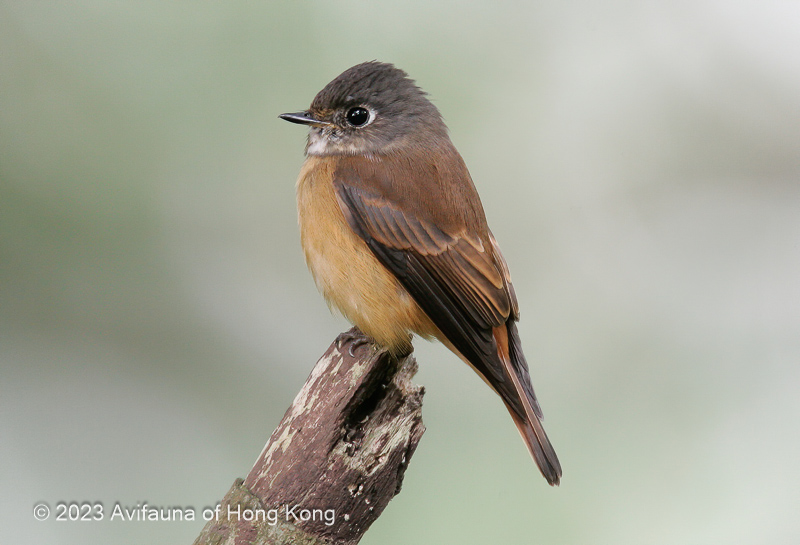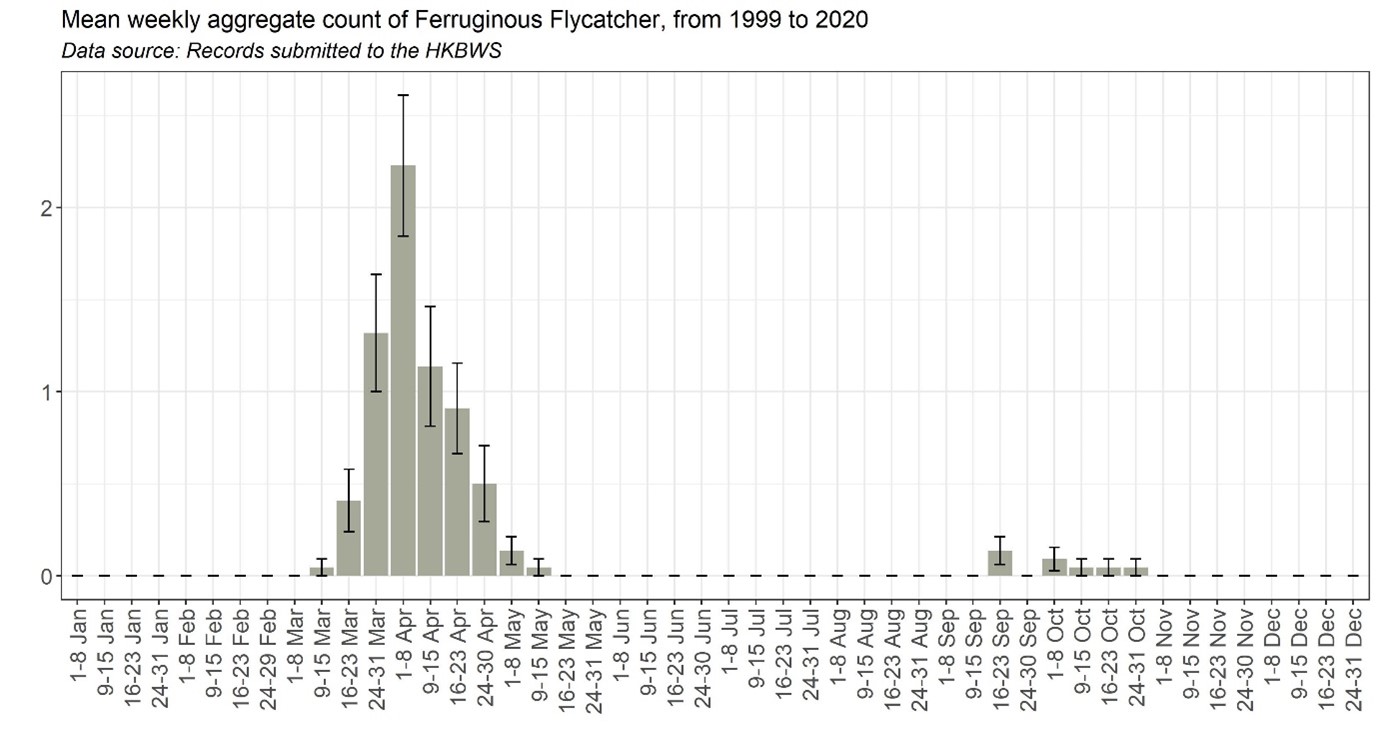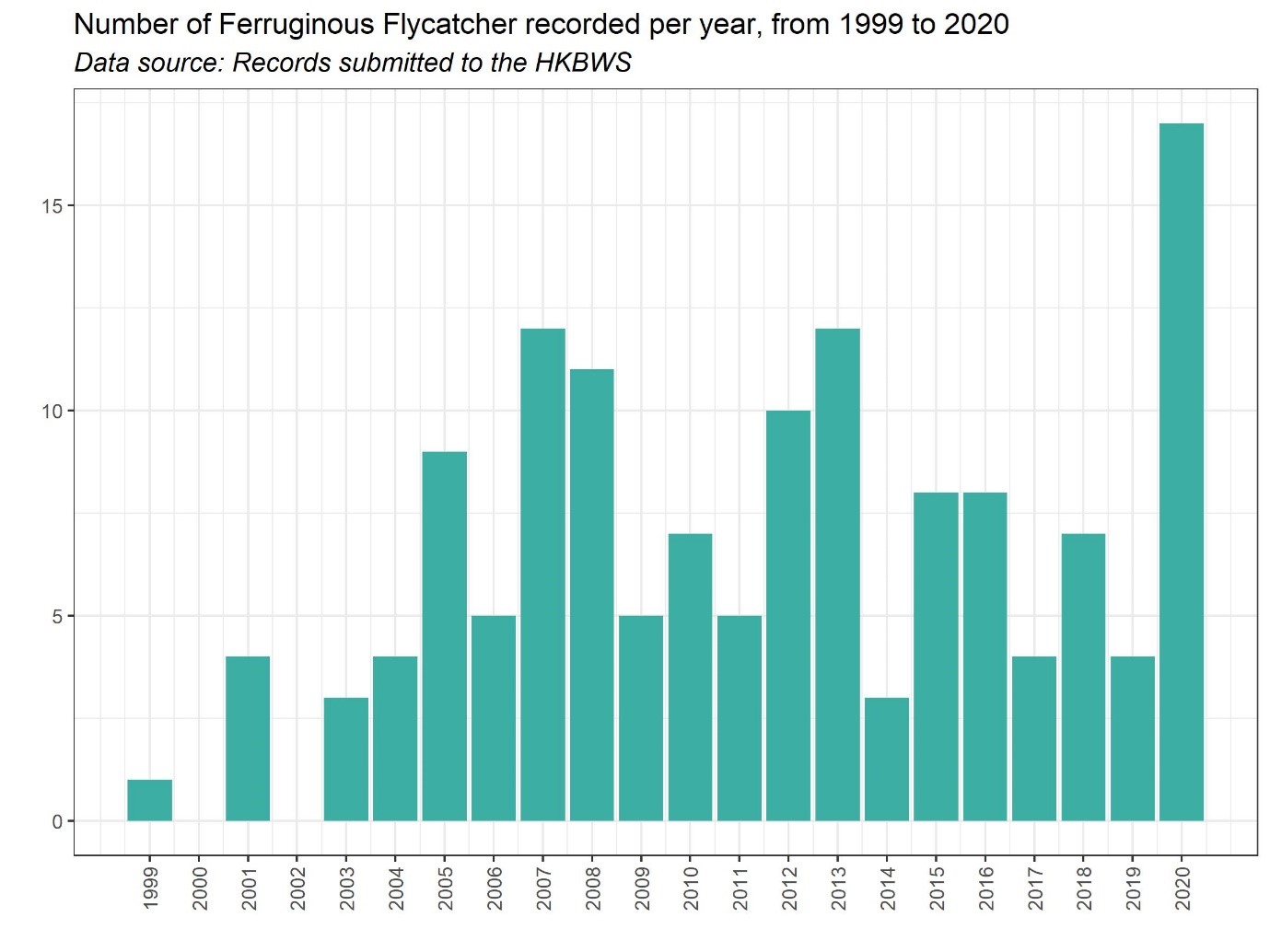Ferruginous Flycatcher Muscicapa ferruginea 棕尾褐鶲
Category I. Uncommon passage migrant to wooded areas in variable numbers, scarce in spring and rare in autumn.
IDENTIFICATION

Mar. 2007, Martin Hale.
12-13 cm. A small to medium-sized flycatcher that has a short bill with pale orange base to lower mandible. Sexes alike. Grey head with a white eye-ring that is broader behind the eye, rich buff above base of bill, whitish submoustachial stripe and dark malar stripe. Brown mantle, rufous-brown rump and uppertail coverts, two rufous-brown wing bars and rufous-brown fringes to the tertials. Breast, flanks and undertail coverts rufous orange. Legs pinkish-brown.
VOCALISATIONS
The calls are very high pitched and rather metallic: single or double-note ‘tsee’ or a short series of notes, e.g., ‘trrrrrrrrrree’.
DISTRIBUTION & HABITAT PREFERENCE
Recorded from widespread sites that have sufficient tree-cover for migrants, including parks in urban areas. In recent years most regularly reported from Po Toi.
OCCURRENCE
Uncommon passage migrant, scarce in spring and rare in autumn. In spring recorded as early as 3 March, with the next earliest on the 14th of that month; the latest date is 14 May. From 1999 to 2020, peak passage occurred from the last week of March to the third week of April (Figure 1) with 84% of spring records occurring in this period; the first week of April accounts for 33% of all spring records. There are a small number of records in the first half of May. Most records involve single birds, with the highest count being five at Mount Austin on 13 April 1992, Tai Po Kau on 1 April 1994, Po Toi on 5 April 2008 and Wu Kau Tang on 5 April 2021.
There have been eleven autumn records of single birds between 13 September and 8 November, mainly in October. All apart from two (1980 and 1992) have occurred since 2003 in different years.
The annual estimated number of individuals reported usually lies between four and 12 (Figure 2). There were no records in 2000 and 2002, while the highest is 17 in 2020, which is probably due to increased observer activity.
The first HK record was of one obtained at Mirs Bay on 6th or 10 April - year unspecified but presumably in the early 1900s (Vaughan and Jones 1913). However, the next sightings did not occur until over 50 years later when up to two were at Pok Fu Lam and Lam Tsuen during 18-25 April 1953 (Dove and Goodhart 1955) and one was at Victoria Peak on 30 March 1957 (Walker 1958).
BEHAVIOUR, FORAGING & DIET
Usually solitary, unobtrusive and quiet. Can allow close approach. Hawks insects from exposed branch; often returns to the same perch.
SYSTEMATICS & RANGE
Monotypic. Breeds from central Nepal east through the Himalayas to central and southern China, Taiwan and north Vietnam; winters in Hainan and southeast Asia, Sumatra, west Java, north Borneo and the Philippines. In China it breeds from southeast Tibet east to south Gansu, south Shaanxi, Sichuan and west Yunnan (Clement 2020). Some birds winter in Hainan and southwest Yunnan (Liu and Chen 2020).
CONSERVATION STATUS
IUCN: Least Concern. Population trend decreasing.
Figure 1.

Figure 2.

Clement, P. (2020). Ferruginous Flycatcher (Muscicapa ferruginea), version 1.0. In Birds of the World (J. del Hoyo, A. Elliott, J. Sargatal, D. A. Christie, and E. de Juana, Editors). Cornell Lab of Ornithology, Ithaca, NY, USA. https://doi.org/10.2173/bow.ferfly1.01
Dove, R. S. and H. J. Goodhart (1955). Field observations from the Colony of Hong Kong. Ibis 97: 311-340.
Liu, Y. and Y. H. Chen (2020). The CNG Field Guide to the Birds of China (in Chinese). Hunan Science and Technology Publication House.
Vaughan, R. E. and K. H. Jones (1913). The birds of Hong Kong, Macao and the West River or Si Kiang in South-East China, with special reference to their nidification and seasonal movements. Ibis 1913: 17-76, 163-201, 351-384.
Walker, F. J. (1958). Field Observations on birds in the Colony of Hong Kong. Hong Kong Bird Watching Society, Hong Kong. (duplicated).

